Spitfire Mk.XIVc/e
& FR Mk.XIVe
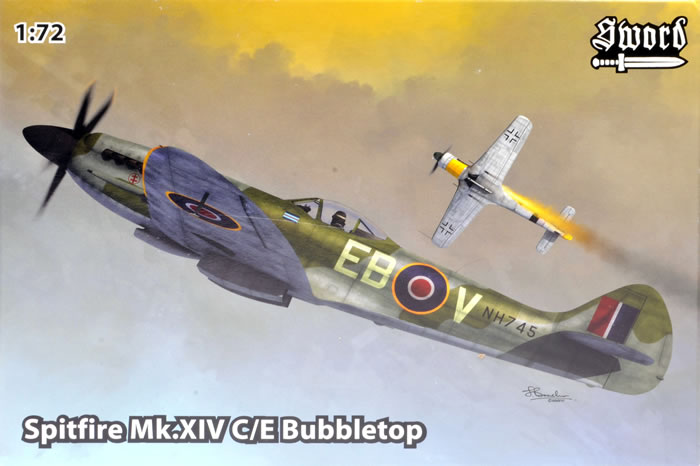
Sword, 1/72 scale
S u m m a r y : |
Catalogue Number: |
Sword Kit Nos.:
SW72095 – Spitfire Mk.XIVc/e
SW72096 – Spitfire Mk.XIVc/e Bubbletop
SW72097 – Spitfire FR Mk.XIVe |
Scale: |
1/72 |
Contents & Media: |
SW72095 – Sixty-nine grey and three clear styrene parts, with
decals for four aircraft.
SW72096 – Assume Sixty-eight grey and four clear styrene parts,
with decals for four aircraft.
SW72097 – Sixty-eight grey and eight clear styrene parts, with
decals for four aircraft. |
Prices: |
Available on-line from these stockists:
Click here for currency conversion. |
Review Type: |
First Look. |
Advantages: |
The best 1/72 Spitfire Mk.XIV kits. Accurate and nicely detailed, Sword has avoided the pitfalls associated with the Fujimi kits’ parts breakdown, whilst improving on the Japanese brand in a number of areas. Also great value. |
Disadvantages: |
The instructions cannot be relied upon at all for correct C or E-wing armament layout; this is because the drawings, part numbering and labelling are jumbled and incorrect, and these errors carry over to the colours and markings plans. All the required parts for either wing type are provided however, but knowledge of their correct fitment is needed.
The instructions, if followed, will also result in the low-back lacking head armour that should be present; but this can be avoided using existing kit parts and a knowledge of what it should look like. |
Conclusions: |
At first glance Sword’s Spitfire Mk.XIV kits appear to be quite similar in execution and quality to Fujimi’s, which have generally been considered the benchmark for the subject in 1/72 scale.
However, closer examination soon reveals a superior approach to parts breakdown, whereby the differences between high-back and low-back fuselages, and C & E-wings, are catered for with individual and complete mouldings. This is a far better approach than Fujimi’s shared parts approach.
Also superior to Fujimi is Sword’s moulding of the standard wingtips with the wings, rather than as separate parts, and having complete ailerons and flaps included with the upper wing panel, thus ensuring sharper trailing edges.
Parts breakdown aside, Sword has provided excellent surface detail that equals Fujimi’s very delicate representation, and has completely outclassed their kits when it comes to cockpit detail.
Sword also holds a clear advantage in a number of smaller detail areas such as correct radiator housings, a correct retractable tail wheel, or several small blisters absent from the Fujimi kits.
I also believe Sword has done a better job of capturing some key shapes and outlines than Fujimi did. This is certainly the case when Fujimi’s undersized chord between the aileron and wingtips is concerned.They avoid Fujimi’s incorrect kink to the rudder hinge, and provide a more accurate rudder and fin fillet outline. I also think Sword’s propeller blades area closer approximation to the real thing. This view also holds true for both the high-back and low-back canopies. Not only is Sword’s shape more accurate, but they are thinner too.
Sword also has the advantage in options covering a choice of wheel types, gun-sights, deep wheel-well blisters, and two choices of exhaust pattern. I also regard Sword’s Techmod decals to be superior to apply than those supplied by Fujimi.
Fujimi’s advantages over Sword are the inclusion of a headrest with the low-back kits, long range slipper tank, and finer undercarriage legs and torque links.
There is one other area that Fujimi beats Sword, and that is in clarity of instructions. I have previoulsy remarked on the seemingly rushed nature of Sword’s instructions, as they often have silly small errors and oversights. But their Spitfire Mk.XIV instructions have made an atrocious and frankly inexcusable mess of outlining the correct armament layout for the C & E-wing options. This will not matter to Spitfire buffs with a detailed knowledge of such matters, but anyone following the instructions runs every risk of making serious assembly errors involving wing type, cannon and machine gun fit, and cannon blister location. I don’t know if it a rush to get to market, or just laziness, that has led Sword to release parts maps, assembly drawings, camouflage & markings and stencil plans that all have erroneous armament layouts depicted.
Despite their instructional dog’s breakfast, Sword has produced great value kits that are deserving of the accolade – By far the best Spitfire Mk.XIV’s in “The One True Scale”. |
Reviewed by
Mark Davies

Sword's 1/72 scale F2H-2N Banshee is available online from
Squadron.com
The Spitfire really needs no introduction, and most readers will already know that the Mk.XIV was the second production variant to be powered by a Rolls Royce Griffon engine, replacing the smaller Rolls Royce Merlin used in earlier marks. However, for those interested in the Spitfire’s general history check out Wikipedia, and for a synopsis of Griffon powered marks, including the XIV, see AirPages.ru.
Previous 1/72 Scale Spitfire Mk.XIV Kits
There are surprisingly few kits of the Mk.XIV in 1/72 scale:
-
Frog was the first with a Mk.XIVc that came boxed with an Fi 103 V1 flying bomb. This has been re-boxed by Ark Models, Eastern Express, Hasegawa (in 1972), Modelhobby, Novo, UPC, and quite possibly others. It was a fair product for its time, but this has long since passed; its inaccuracies and weaknesses make it unworthy of serious consideration these days.
-
Aeroclub issued a vac-form & white metal high-back conversion for the Airfix Mk.Ia to make a Mk.XIVc, or the Heller Mk.XVIe to make a Mk.XIVe. This was presumably to offer a accurate Mk.XIV solution than the Frog kit, or may have been intended to fill a gap when Frog ceased production, and prior to Novo re-boxes becoming available. It is now out of production and the need for it has passed.
-
Ventura offered Mk.XIVc/e high & low-back kits. They are generally very accurate but extremely limited run and crude in nature, with far more work needed than most are willing to do to get a nice model; they are kits for the masochists amongst us. Ventura’s toolings were acquired by Jays Models, but the Spitfire Mk.XIV has yet to be reissued by them.
-
Fujimi has issued numerous boxings covering the Mk.XIVc and the MK.XIVe in high & low-back versions (the same basic tooling is also found in the Spitfire PR Mk.XIX). The kit features very fine surface detail and is typical of Fujimi’s 1990’s products. It looks nice in the box, was expensive and hard to find new in many markets, but can be bought second hand for reasonable money. It has some fit issues due to its engineering for multiple versions. Despite being the best Mk.XIV for many years it still has some significant weaknesses; these include:
-
The high back versions have an exaggerated curve to the fuselage spine and look a bit bloated, plus the bulged canopy’s sliding section is a little oversized.
-
The high and low back kits share the same fuselage halves with separate spines, and the spine fit for the high back in particular is dreadful.
-
The wings are under undersized in chord from about mid-aileron outboard to the tips.
-
All versions have mediocre cockpit detail, undersized radiator cooling flaps (easy to fix), and are moulded with the tail-wheel doors closed; which means they must be cut open and have a mounting point for the tail-wheel fabricated.
-
Some also think they have slightly undersized tailplanes and that the prop blades that are not quite right (the tailplane seems acceptable to me, but I do have some small doubts about the prop - see later).
Quickboost makes ‘correctional’ parts for the spine, tailplane and prop; and they offer radiators which have the same fault as the kit ones (they appear to be just resin copies of the assembled kit parts). These items just add to cost to an often already overpriced kit. Quickboost also makes replacement exhausts and a replacement upper cowl panel (which seems to just be a copy of the joined kit parts).
-
Academy’s Mk. XIVc is readily available, and the contents look very nice at a quick glance; but unfortunately it looks dreadful when assembled. Low price and a good fit are its only real virtues. It has a ridiculously oversized canopy, a curious hump to the spine, a fat-looking fuselage, poorly shaped bulges in the cowl, radiators at the wrong angle to wing to facilitate withdrawal from the mould, and numerous other shape and dimensional issues. I think it is best avoided altogether, yet it is a popular build choice on some forums.
-
AZ Model/Legato produced a Mk.XIVc and Mk.XIVe in high & low-back versions (also re-boxed by Freightdog). These are generally accurate, have nice detail, but suffer some fit and canopy quality issues. An advance on Fujimi’s kits in some respects, but still leaving plenty of room for improvement. They are well priced from the right suppliers, but need some extra work, a Falcon canopy, and possibly a Quickboost prop to look their best. However, their truly limited run nature will put some off from building them.
Contents
All three Sword kits come in end-opening boxes with digital artwork on the front and colour profiles of the markings options on the rear.
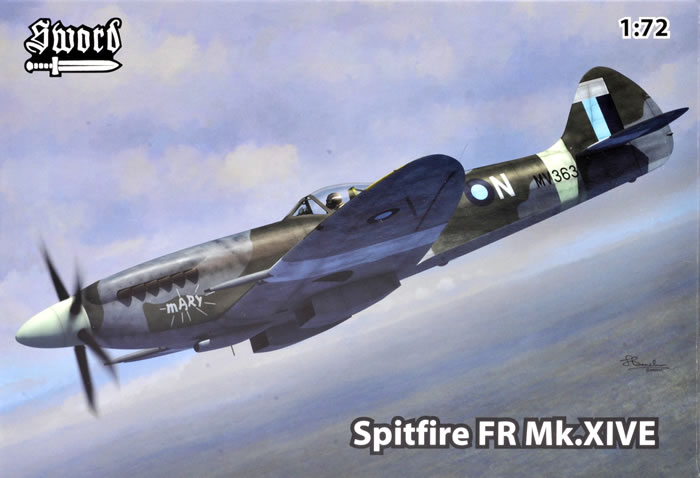
The decals, plastic and resin parts come in a zip-lock bag, with the clear parts further enclosed in a small bag of their own.
I received boxes SW72095 and SW72097 from Brett to take a first look at, whilst he kept SW72096 for a future build. I have listed all three kits here as SW72096 & SW72097 are almost identical, so my observations should apply equally to both boxings.
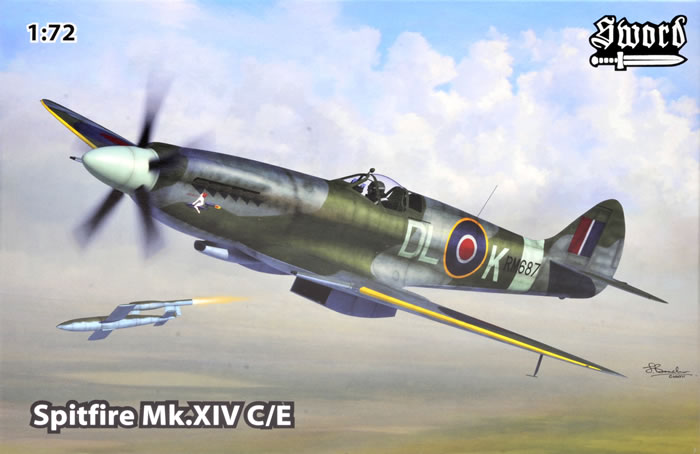
The Instructions
These kits have reverted to Sword’s old-style of instructions despite several recent Sword samples featuring an excellent A4 sized stapled booklet printed in colour, and notable for their very large and clear assembly illustrations, plus full-colour four-view colours and markings drawings. The old-style instructions still look good, with nice assembly drawings* and colour for the painting and markings section, but they are printed on paper half the size as two folded A4 and a single A5 unbound sheets.
The instructions include a parts map, a brief aircraft history, with all text in English.
- An observation - Whilst I have always found Sword’s instructional drawings to be very nicely rendered, they often illustrate a bit more detail than is actually incorporated in some of the parts; usually this applies to small details and is not of any real consequence. In the case of these review kits parts like the rudder pedals, cockpit floor and prop blades in print look a tad shapelier than in the plastic.
Where necessary in this ‘first look’ I shall indicate kit part numbers by enclosing them in square brackets like these [_].
General Appearance
These are typical Sword kits with nicely moulded parts, fine surface detail, and superb fabric surfaces. In fact, the surface detail is about as good as it gets in this scale, certainly equal or better than Tamiya and Hasegawa etc. (Although ICM and some resin brands like Prop & Jet manage to impart a highly realistic and more 3D effect to their surface detail than any other brands.)
The runners have reasonably narrow gates, and there is a tiny hint of flash in several places, but this is very easy to deal with. There are also quite a few prominent ejector stubs, fortunately in areas that cannot be seen. Some will require removal in order for parts to fit correctly; but again, this is easily done. Parts break down is conventional for the type. The canopy parts are clear and acceptably thin.
There are some significant engineering differences in parts breakdown between the Sword and Fujimi kits. Yet it seems clear from a parts comparison that the Fujimi kit probably formed the “raw bones” of Sword’s master, or at least had an overwhelming influence on it; so similar or sometimes identical are many of the parts.
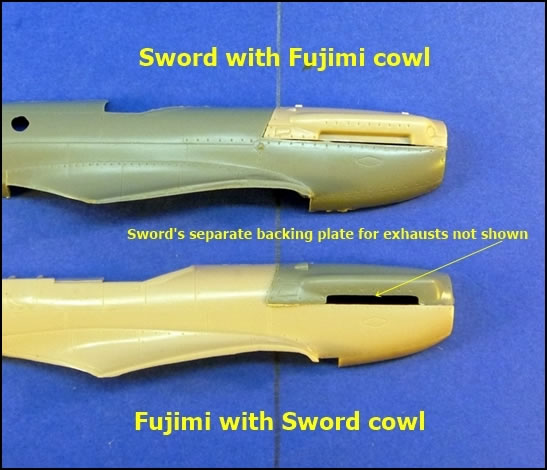
This is not unusual practice for limited run manufacturer’s to follow when preparing positive masters for epoxy or metal-coated epoxy tools. Given this assessment, and because for many Fujimi’s kits have been the preferred choice for a 1/72 Spitfire Mk.XIV, I shall make comparisons between the two brands throughout this ‘First Look’.
Low & High-Backs
Pleasingly, Sword has not followed Fujimi’s approach of sharing complete fuselage and wing parts between the high and low-back versions. This immediately avoids what is the Fujimi kits’ major constructional weakness.
C & E-Wings
Another difference between Sword’s and Fujimi’s kits is that Sword does not require the modeller to fill case ejection chutes in the C-wing when building an E-wing. Instead, there is a runner with a full high-back fuselage and lower C-wing that has the .303” machinegun extraction chutes moulded in, and another with a full low-back fuselage and lower wing E-wing with smooth panels in place of the chutes and blisters. Sword has included the small blisters behind the C-wings machinegun ejection chutes, and moulded these as true openings in the wing, whereas the Fujimi kit lacks the blisters and the chute opening are only defined by engraved lines.
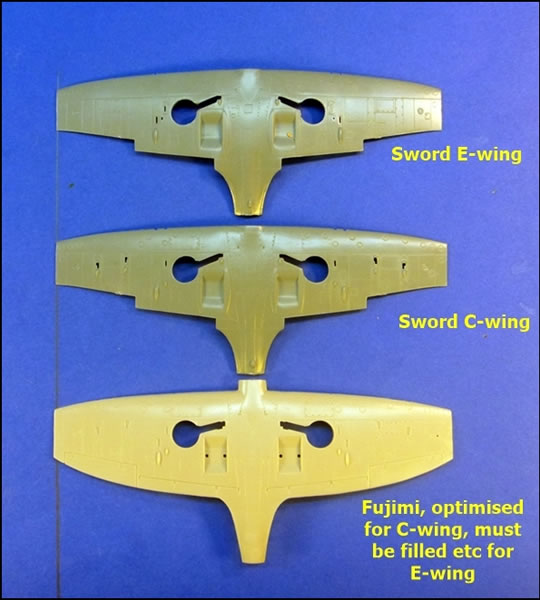
The C-wing’s outboard guns aside, the kits cater for the long 20mm cannon sheath & blanking-cap of the C-wing, and the shorter 20mm cannon sheath and .50” machine gun of the E-wing. Cannon breech blisters are separate from the wing enabling them to be positioned over the inboard gun bay forward for a C-wing, or the outboard bay rearwards for the E-wing. This would all be well and good if only Sword’s instructions could correctly explain and illustrate the differences between the C and E-wing armament layout (see later).
Cockpit
Cockpit detail is good for the scale, and will only require the addition of seatbelts for a satisfactory closed canopy model, or an adequate open canopy display. However, only the bubbletop kits have an open canopy option (although the parts map and assembly drawings show this as a single-piece part). Both canopies are capped by a rear-view mirror. The interior detail includes:
-
Structure and controls moulded integrally with the sidewalls.
-
Floor with solid rudder pedals, instrument panel, seat, armour plate, and control stick.
-
Compressed air bottles for the plane’s pneumatic systems.
-
A choice of gun-sights, either the earlier GM2 or later Gyro Mk.II.
-
The high-back has a small hooped frame to insert in the fuselage opening at the immediate rear of the canopy, and there is a choice of fuselage frame that locates behind the seat; one for the high-back with a panel that sits above the cockpit coming, and one without for the low-back versions that fits just beneath the fuselage decking behind the cockpit opening.
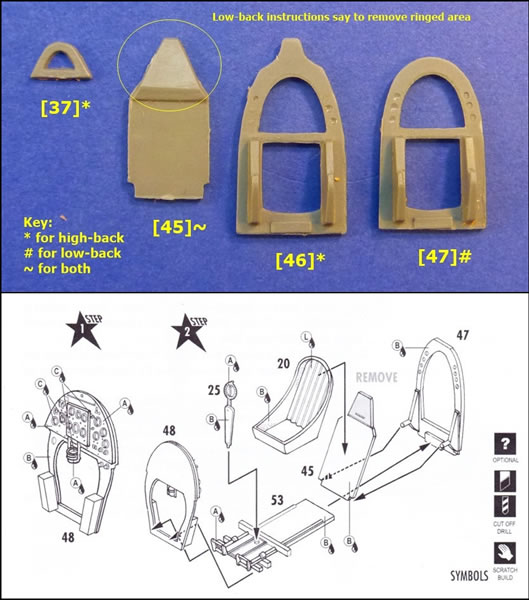
The instructions illustrate the low-back as having the armoured headrest braced by a triangular plate incorporating three lightening holes, yet this is not reflected in the parts supplied. This is a good thing as it would be incorrect! The instructions reflect the style of headrest brace found in the Spitfire Mk.IX & XVI low-backs, and Mk. 22 & 24, whereas the Mk.XIV low-back headrest is braced by a slim angled rod.
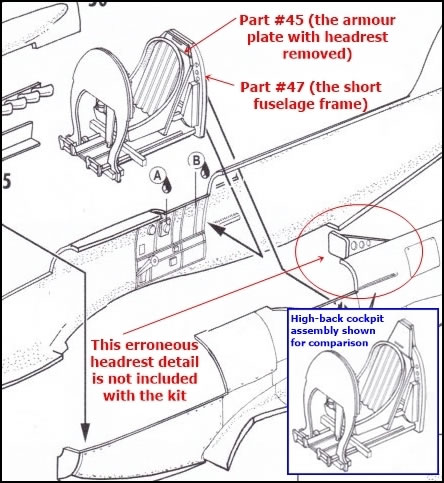
The armoured headrest is incorporated with the seat armour [45] found in both boxings, but the low-back’s instructions direct to cut the headrest from the seat armour. I would advise to leave the headrest portion of the seat armour in place. I would then file a notch in the fuselage decking behind the seat to accept the high-back’s fuselage frame [46], and use this in place of the low-back’s frame [47], as this will better reflect the original’s appearance. Then I would add a piece of plastic rod or stretched sprue to the protruding bulk head for the brace. Alternatively, use the photos to scratch-build a superior and more refined representation of the headrest. I suggest also to adding the filler nozzle for the fuel tank located behind the seat that is missing from the kit (also overlooked by Fujimi) as shown in these photos...
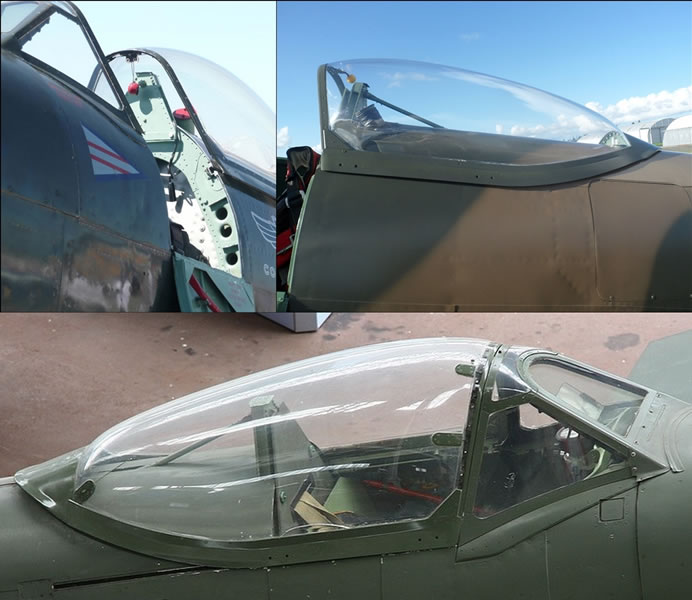
Whilst mentioning scratch-built detail enhancements to the rear seat area, it is worth noting that the high-back has a bracing rod running from the headrest armour [45] through the fuselage frame [46] just behind it and on back to the hooped frame [37] as shown in the photo below...
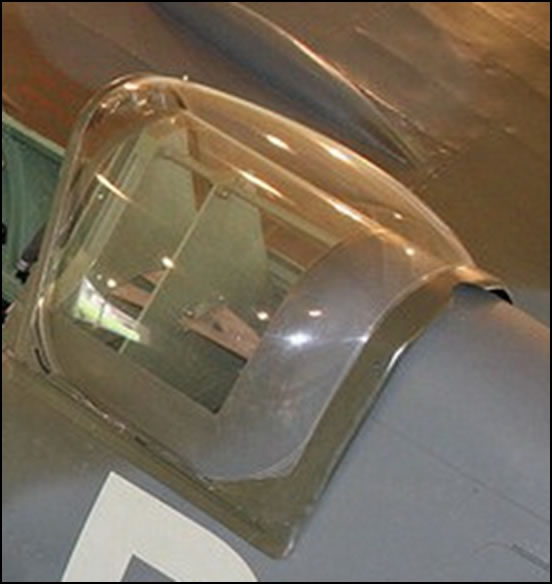
Fuselage
The fuselage halves enclose the cockpit, and unlike Fujimi’s kits, correctly have a tail wheel bay and separate doors. The forward upper cowling is tooled in the same way as Fujimi’s, with separate halves to enable the engine bulges to be incorporated using a two-piece mould. Just like Fujimi’s kits, this will no doubt prove a slightly fiddly area to assemble and finish nicely given the thin locating edges, seam locations and adjacent engraved detail. The best approach is usually to fit the cowl parts to each fuselage half first, then join the fuselage halves; as opposed to joining the cowl halves and fuselage halves as separate sub-assemblies, then joining the two to complete the fusleage.
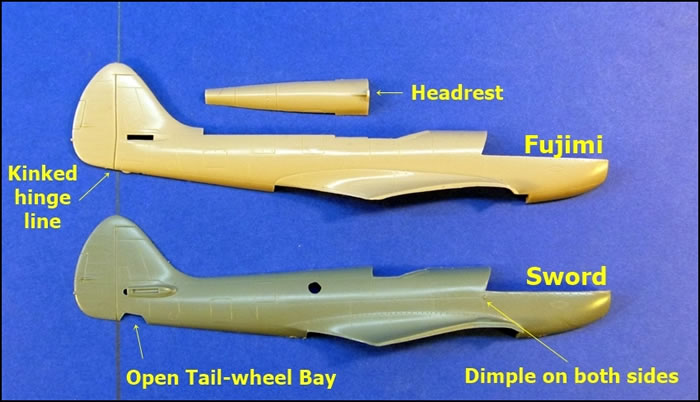
Unlike Fujimi, Sword has chosen not to mould the exhaust mounting plates with the cowl parts; instead these must be fitted separately. A choice of round or fishtail exhausts is provided, but no guidance is given as to which should be fitted for what colour scheme. Both types of exhaust types are just adequate in appearance as supplied, and lack open mouths. These can be carefully drilled out, or suitable resin replacements can be sought.
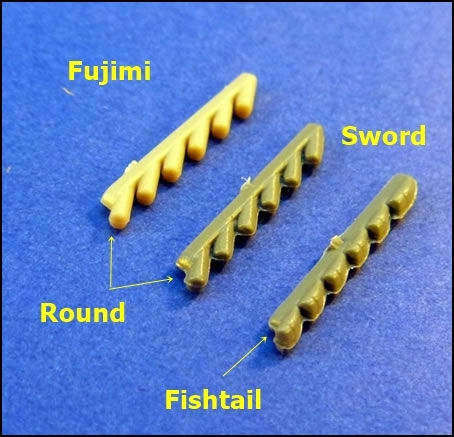
My reading leads me to think that most, if not all, Mk.XIVe’s would feature the later round exhausts, and that they could be found on some Mk.XIVc’s as well.
The FR Mk.XIVe (SW72097) has holes moulded in each side of the fuselage to take clear panels for the camera windows. I am unsure, but have a feeling that sometimes one or other window was blanked depending on which side the camera faced, although I have seen photos where a clear view right through the fuselage was possible, which clearly indicates windows fitted to both sides.
The FR Mk.XIVe also had two circular windows for a vertical camera in the underside of the fuselage. These are absent from the kit, as is the panel line surrounding them; probably due to tooling limitations. Sword’s instructions provide a drawing illustrating where the two 4mm holes should be drilled, and show the oval-shaped panel line that surrounds them that will need to be scribed.
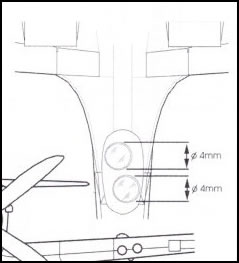
Unfortunately, the two holes are located both sides of, and immediately adjacent to, a seam line where the lower wing meets the fuselage; so extra care will be needed. The kit includes glazing for these two ventral and both side windows, but no camera detail.
I understand that the low-back Mk.XIVc/e boxing (SW72096) has fuselage sides without any holes in the fuselage sides.
The propeller, like Fujimi’s, consists of five separate blades, a backing plate, and spinner. The blades have small lugs at their base to aid location within the backing plate. Sword’s limited run moulding means that these and their locating holes are not quite as crisp as Fujimi’s long-run parts, so I suggest drilling the holes in the backing plate out a little more. There are slight differences in shape between the two brands’ blades, and this is discussed in more detail later.
A simple two-piece carburettor air intake and horizontal stabilisers complete the fuselage.
Wings
The wings are straightforward enough. Unlike Fujimi’s kits, which feature pre-clipped wings that take either clipped wingtips or rounded wingtips, Sword has moulded its wings with the standard rounded tips in place. For clipped wing versions it is necessary to cut these off and fit the clipped wingtips. I think this is probably a better option than Fujimi’s, as it is easier to blend in clipped wingtips than rounded ones.
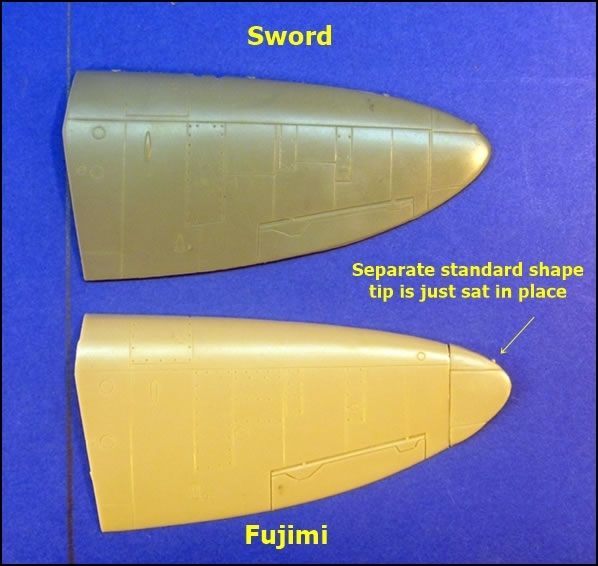
Another Sword improvement is moulding both faces of the ailerons and flaps with the upper wing half, which provides a thinner trailing edge and no join at this point. The Fujimi kit has these surfaces are split between top and bottom wing halves resulting in a join along a thicker trailing edge.
As mentioned earlier, Sword’s separate C and E wing undersides provide a better option than found in Fujimi’s kits. This is because Fujimi’s lower wing is optimised for a C-wing, so building an E-wing option requires that the ejection chutes must be filled and blisters removed or scratch-built.
The radiator/intercooler housings are nicely done, featuring separate matrix facings and avoid Fujimi’s error of short cooling flap length. Also apparent is the ducting hollow in the bottom wing where the radiators mount is smoothly contoured in the Sword kits, whereas Fujimi’s ducting is flat and angular. I cannot say which is the more correct, and it will be barely noticeable anyway.
Tailplane
Sword has engineered the root of the tailplanes slightly differently to Fujimi, but both have the same outline and correspond to the plans I had.

Undercarriage
Wheel-wells are enclosed and have adequate detail that is fractionally superior to Fujimi’s. The main undercarriage legs feature separate torque links (these are in a different location on the parts runner than indicated in the parts map). Sword’s torque links are moulded solid, where Fujimi’s feature an open gap as per the real link. Although Fujimi’s link detail is a little finer and crisper, a shadow wash over the Sword parts should impart an adequate appearance.
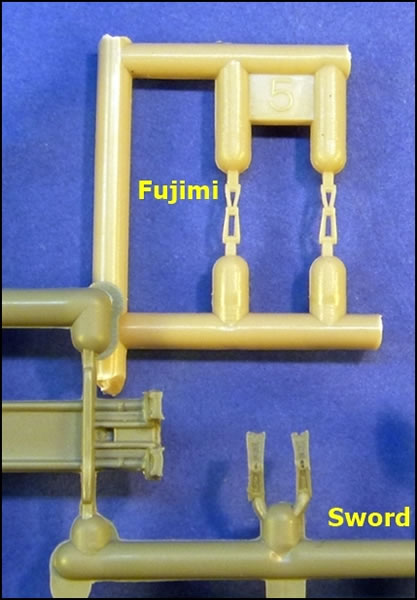
The legs, undercarriage doors and wheels all appear satisfactory, although Fujimi’s long-run tooling manages to mould these parts more crisply. Sword provides the option of 3 or 4-spoke wheels, where Fujimi only has the latter.
As mentioned earlier, Sword correctly caters for a retractable tail wheel, where Fujimi’s is incorrectly tooled for a fixed tail wheel (although the engraved tail wheel doors can be cut out and the tail wheel jury-rigged to look right).
A Complete Cock-up on the Armament Front!
Rather than be too alarmist, I should explain that if you understand the differences in armament configuration commonly fitted to C & E-wings, then all the parts you need are supplied with the kits. So if you know your spits wing types you need not read what follows and can jump ahead to the Optional Wheel Blisters section, as you will not be relying on Sword’s instructions. If however you do need to be guided by the instructions, read on...
Unfortunately, the instructions for both SW72095 and SW72097 are very confusing and full of errors when it comes to illustrating the armament fit; here’s why (part numbers as per the parts map are given in square brackets below):
- Both SW72095 & SW72097. The parts map identifies the E-wing armament of short cannon barrel and 0.50” machine gun as incorrectly being for the C-wing, and vice-versa for the cannon barrel and blanking cap.
SW72095’s Instructions:
-
Correctly draw the C-wing option of long cannon barrels [63] and blanking caps [64] (which the parts map labels as being for the E-wing) but incorrectly numbers the parts in the drawing as 61 and 62 respectively. It at least correctly illustrates the lower C-wing with ejection chutes [59].
-
Then, for the E-wing option they correctly illustrate short cannon barrels [61] (which the parts map incorrectly labels as being for the C-wing) but incorrectly numbers the parts 63 in the drawing; and worse still, draws the flat-faced 0.50” machine gun [62] (which the parts map incorrectly labels as being for the C-wing) as a domed blanking cap [64] like that used on the C-wing! Also confusing is the lower wing is correctly numbered [60] for an E-wing as per the parts map, but is drawn as being for a C-wing with the ejection chutes found part number 59!
-
Things don’t get any better with colours and marking plans. The three E-wing options are drawn with the cannon in the E-wing position but with the C-wing’s blanking dome where the E-wing’s 0.50” machine gun goes, and to add insult to injury, the cannon blisters are in the forward-inboard position over the bank/machine gun rather than the rearward-outboard position over the cannon. Only the single C-wing scheme is correctly drawn armament-wise! As an aside, the stencil location drawing correctly illustrates a C-wing layout.
-
The assembly illustrations fail to differentiate the position of upper wing cannon blisters for the C and E-wings. The colours & makings and stencil location plans correctly show the C-wing layout, but their E-wing is incorrectly illustrated.
- Finally, and if building a C-wing, the modeller can paint blanking patches over the four outboard .303 machineguns, or open up their blast holes in the wing’s leading edge. The positions are not marked on the kit, but they should be penetrate a tiny fraction higher than the wing centreline when viewed head-on, and be centred within the gun access hatches moulded in the upper wing.
SW72097’s Instructions:
-
These should only illustrate the E-wing option, as this is the only wing applicable to this boxing. However, it manages to correctly draw the E-wing’s short cannon barrels (which the parts map incorrectly labels as being for the C-wing) in the correct outboard position for an E-wing, but incorrectly numbers them [65] which are the C-wings long cannon. To make matters worse, they also illustrates the C-wing’s blanking cap [66] (which the parts map incorrectly labels as being for the C-wing) instead of the correct E-wing’s 0.50” machine gun [64] (again incorrectly labelled by the parts map lists as being for the C-wing). Then it correctly numbers the lower E-wing [60] but illustrates the incorrect lower C-wing [59]!

- Things don’t get any better with colours and marking plans. The four E-wing options are drawn with the cannon in the E-wing position but with the C-wing’s blanking dome where the E-wing’s 0.50” machine gun goes, and to add insult to injury, the cannon blisters are in the forward-inboard position over the bank/machine gun rather than the rearward-outboard position over the cannon.
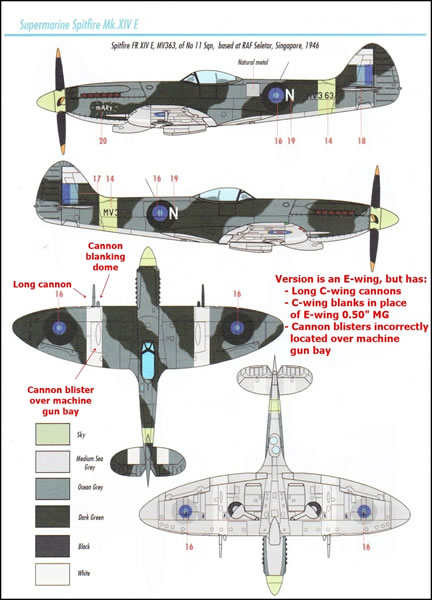
- The assembly illustrations also fail to clearly identify the position of upper wing cannon blisters. The colours & makings incorrectly show the blister in the forward-inboard position, where the machinegun is located, whilst the stencil placement plan correctly illustrates a C-wing layout that does not apply to this boxing!
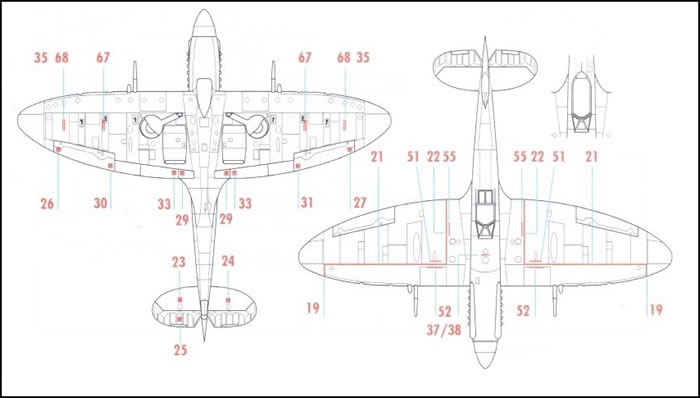
- SW72096. Although I don’t have this boxing, I can only guess it’s a similar dog’s breakfast when it comes to illustrating the armament layout for its C & E-wing options.
Optional Wheel Blisters
Whilst dealing with the wings I should also mention the optional wheel-well blisters. I believe these were fitted to Spitfires when their main-wheel axles were re-angled in relation to the undercarriage legs to track better on concrete rather than grass runways, but I have also read claims they are to accommodate fatter tyres.
The changed angle meant there was not enough space to accommodate the wheel with the leg retracted, so a bulge was added to the wing above the wheel-bay to provide clearance. Sword provides the bulge as an option in all boxings, but no guidance as to which colour schemes it applies to (all are drawn without it).
The instructions also fail to adequately illustrate its correct position, although to fit the bulges in place they need to sit directly inboard from, and almost touching a very small streamlined blister moulded on each wing above the wheel-well. My Fujimi kit does not feature the bulged wheel-well option, and only represents the small blister with an engraved outline.
Generally, I think it is a post-war feature, as increasingly the aircraft were stationed on major bases with concrete runways. I also have to mention that I cannot recall seeing photos of MK.XIV’s with these bulges, they seem more common to late Mk.IXe’s and Mk.XVIe’s.
Outline Comparison to Fujimi Kits
As mentioned earlier, the two brands of kit have many similarities, but generally Sword has eliminated many of the Fujimi kit’s weaknesses by improving the parts breakdown and using dedicated high and low-back fuselages, integrating the flaps and ailerons with the top wing half, and has improved constructional ease and accuracy by supplying alternate lower wing halves for the C & E-wing options.
I would wager that despite being a limited run kit that the Sword Mk.XIV’s will be no more difficult to build then Fujimi’s, in part because the Japanese kits, especially the high-backs, have some awkward fit issues. Chances are that Sword will have the edge for airframe assembly fit, although it will definitely be a more demanding in terms of parts clean up and prep.
I am usually inclined to compare a new kit with a reference kit that has been around for many years, is generally regarded as being the best available for some time, and whose failings are well documented. Fujimi’s Mk.XIV fits this requirement very well. Of course I also take into account photo images of the real plane where possible, and sometimes even original drawings from a mate who works for a leading warbird restoration company.
I am normally cautious of comparing kit parts to plans, as plans can often be inaccurate. However, I did choose to use some in this case, being those by P.B. Cooke, dated 1977, and published in Scale Models magazine’s October 1978 issue. Both kits matched the plans closely, with Sword slightly less so around fin and rudder; which is a good thing as I feel the plans are slightly wrong in this area! (Read why a little further down.)
I only had Fujimi’s FR Mk.XIVe (Kit # 72005) to compare with the two Sword kits, but this was still sufficient to give a very fair comparison that will apply to all boxings. Here is a summary of the differences between the kits that give Sword a clear advantage over Fujimi:
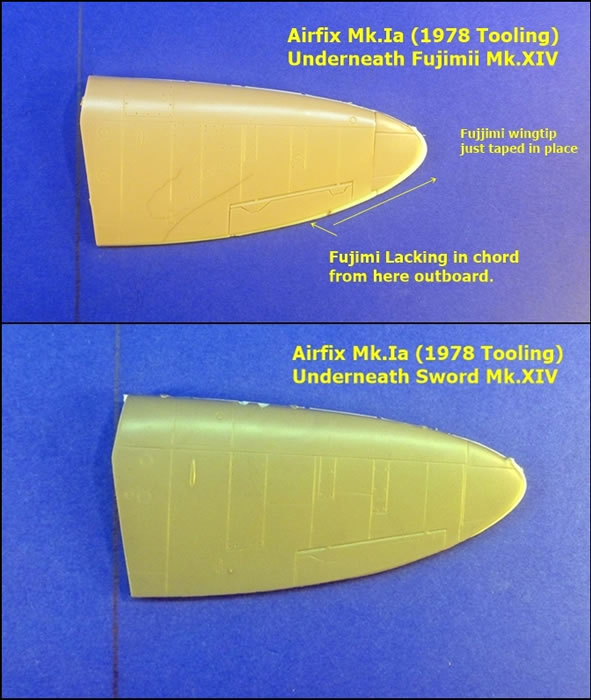
-
Choice of gun-sights.
-
Correctly shaped and sized high-back canopy and is also thinner and clearer; whilst low-back canopy is better shape, slightly shorter, can be positioned open or closed, and is thinner and clearer.
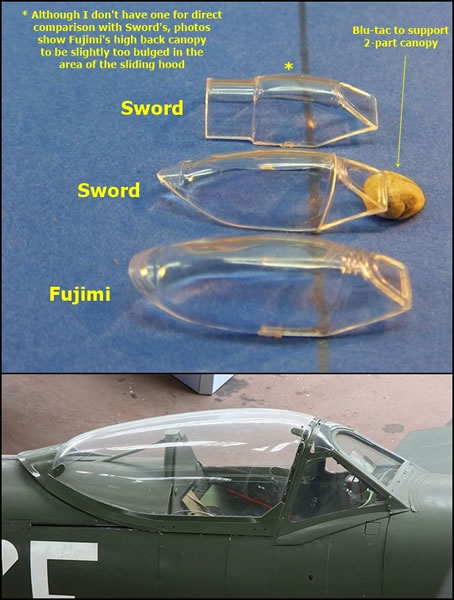
- Rudder hinge line is correctly straight (Fujimi’s is kinked at the bottom 15% or so, as it is also in PB Cooke’s plans!). I also think that Sword’s fractionally smaller rudder outline and forward fin fillet better approximates to the shape depicted by Vickers' drawings and photos of the real plane.

-
Tail-wheel well and separate doors included.
-
Choice of 3 or 4-spoke wheels.
-
Choice of exhaust type (however, Fujimi C-wing boxings may include early fishtail exhausts as the runner with the exhausts suggest an interchangeable part the tool).
-
Correctly includes the tiny elongated wing blisters above wheel wells.
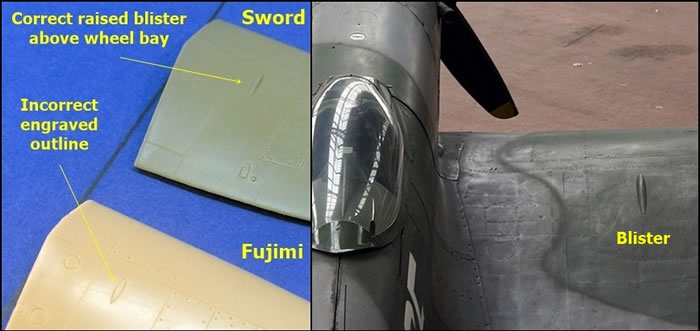
- Correctly includes small blister fairings on lower wing panels behind ejection chutes and near undercarriage leg hinge. It also has the chutes depicted by openings in the wing, rather than just engraved outlines.
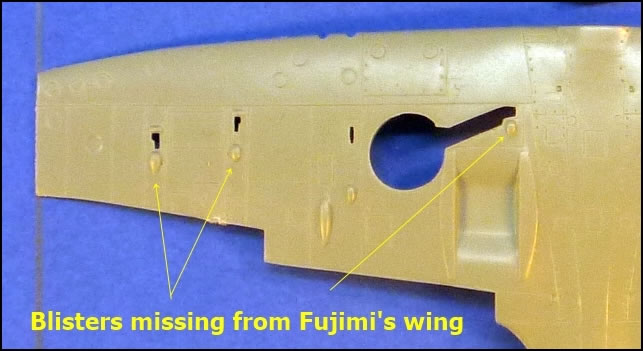
-
Provides optional bulged wheel well blisters.
-
Radiator housings feature correct cooling flap length (the slightly less angular radiator ducting let into to the bottom of the wing may or may not be more accurate, I cannot say).
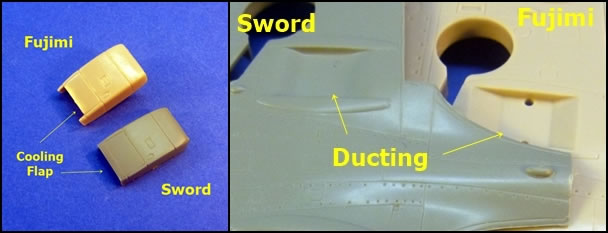
- Propeller differences are hard to decide - There are small differences between the shape of the two brands’ propeller blades, Fujimi’s are fractionally shorter, fractionally more pointed, with slightly wider root with a tad more twist in their pitch. Comparison to PB Cooke’s plans show both match the chord in the developed profile, but Fujimi’s is closer to the plan’s blade profile at the root, and is also closer for blade length (Swords is about 0.05mm longer). Both differ a little from the plan’s tip shape. More important is the comparison to photos, and it is here that I think Sword has the edge, particularly with the less developed twist at the root, and the less angular tip shape. But there’s not a lot in it.
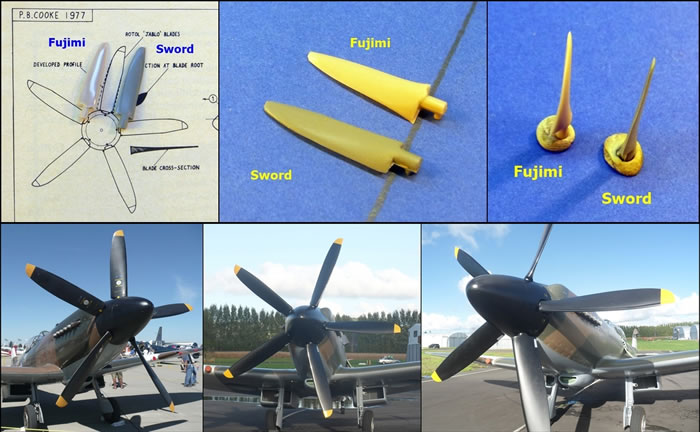
And those areas where Sword is inferior to Fujimi:
-
The low-back kit’s instructions will result in a model that lacks a headrest (although this can be avoided), whilst Fujimi at least provides an approximation of this part.
-
One or two small detail parts like the undercarriage legs and torque links are more crisply moulded to higher pressure long-run tooling.
-
No long-range auxiliary fuel tank (a minor issue in my view).
Marking Options
Both of the review kits come with four decal options for which RAF and generic names are used to describe the applicable colours. Colour tones in camouflage and markings drawings are often off a bit, so check references for the yellow IFF strips on the wing leading edges, as Sword’s depiction is nearer orange; whilst those colours with RAF names can easily be matched to your preferred paint range.
The decals are printed by Techmod, include stencil markings, and look to be of very good quality. This is another area where Sword scores over Fujimi, as in my experience Techmod decals are far better than those supplied by Fujimi with its kits.
The schemes offered with each boxing are shown in the scans of the box rears below:
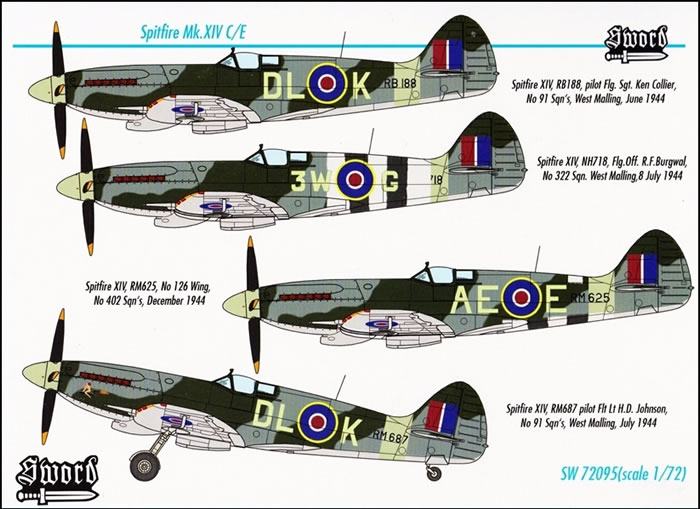
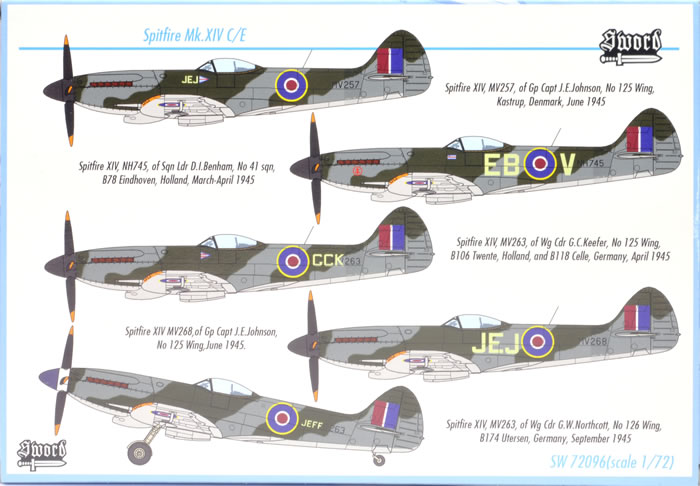

At first glance Sword’s Spitfire Mk.XIV kits appear to be quite similar in execution and quality to Fujimi’s, which have generally been considered the benchmark for the subject in 1/72 scale.
However, closer examination soon reveals a superior approach to parts breakdown, whereby the differences between high-back and low-back fuselages, and C & E-wings, are catered for with individual and complete mouldings. This is a far better approach than Fujimi’s shared parts approach.
Also superior to Fujimi is Sword’s moulding of the standard wingtips with the wings, rather than as separate parts, and having complete ailerons and flaps included with the upper wing panel, thus ensuring sharper trailing edges.
Parts breakdown aside, Sword has provided excellent surface detail that equals Fujimi’s very delicate representation, and has completely outclassed their kits when it comes to cockpit detail.
Sword also holds a clear advantage in a number of smaller detail areas such as correct radiator housings, a correct retractable tail wheel, or several small blisters absent from the Fujimi kits.
I also believe Sword has done a better job of capturing some key shapes and outlines than Fujimi did. This is certainly the case when Fujimi’s undersized chord between the aileron and wingtips is concerned. They avoid Fujimi’s incorrect kink to the rudder hinge, and provide a more accurate rudder and fin fillet outline. I also think Sword’s propeller blades area closer approximation to the real thing. This view also holds true for both the high-back and low-back canopies. Not only is Sword’s shape more accurate, but they are thinner too.
Sword also has the advantage in options covering a choice of wheel types, gun-sights, deep wheel-well blisters, and two choices of exhaust pattern. I also regard Sword’s Techmod decals to be superior to apply than those supplied by Fujimi.
Fujimi’s advantages over Sword are the inclusion of a headrest with the low-back kits, long range slipper tank, and finer undercarriage legs and torque links.
There is one other area that Fujimi beats Sword, and that is in clarity of instructions. I have previoulsy remarked on the seemingly rushed nature of Sword’s instructions, as they often have silly small errors and oversights. But their Spitfire Mk.XIV instructions have made an atrocious and frankly inexcusable mess of outlining the correct armament layout for the C & E-wing options. This will not matter to Spitfire buffs with a detailed knowledge of such matters, but anyone following the instructions runs every risk of making serious assembly errors involving wing type, cannon and machine gun fit, and cannon blister location. I don’t know if it a rush to get to market, or just laziness, that has led Sword to release parts maps, assembly drawings, camouflage & markings and stencil plans that all have erroneous armament layouts depicted.
Despite their instructional dog’s breakfast, Sword has produced great value kits that are deserving of the accolade – By far the best Spitfire Mk.XIV’s in “The One True Scale”.
Thanks to Sword Models for this review sample.
Review Text Copyright © 2016 by Mark Davies
Images Copyright © 2016 by Mark Davies and Brett Green
Page Created 28 September, 2016
Last updated
30 September, 2016
Back to HyperScale Main Page

|
